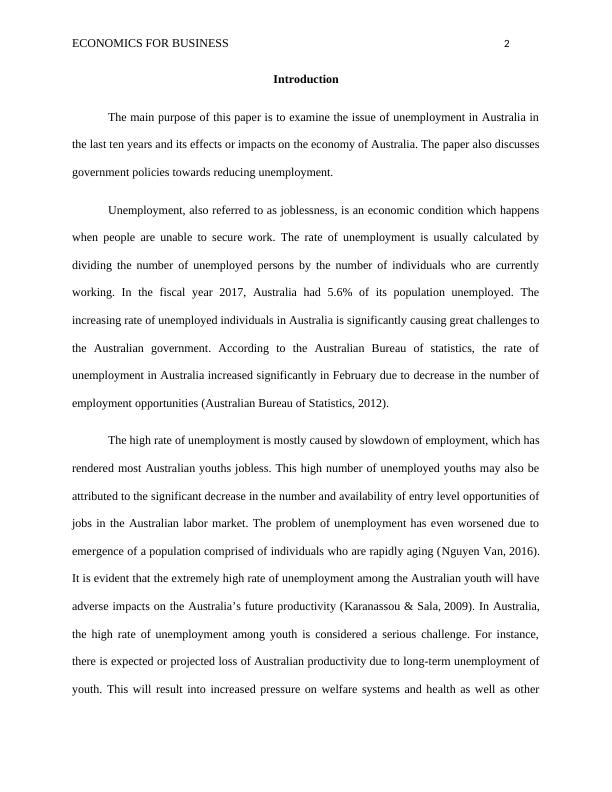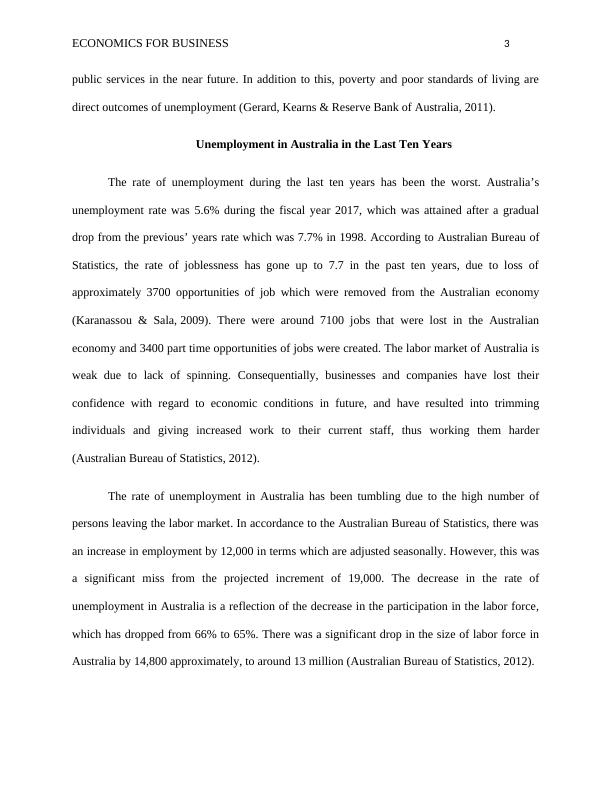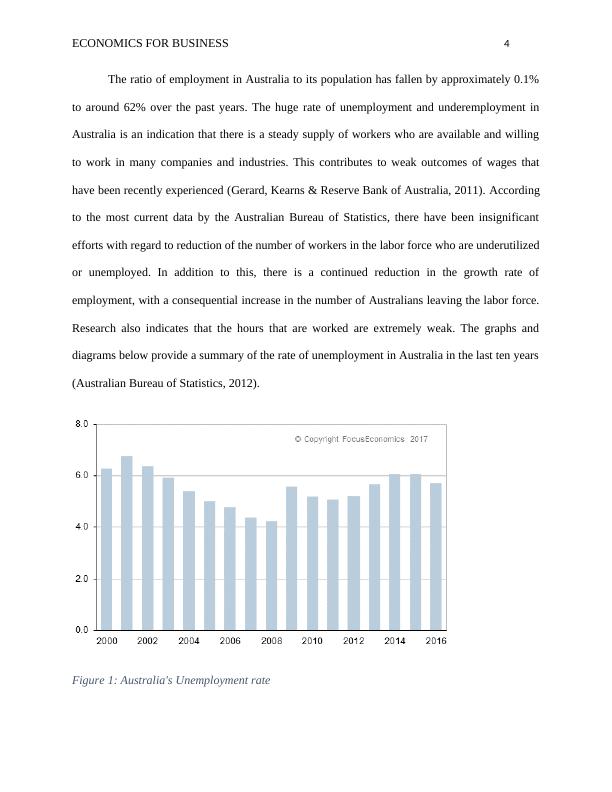Unemployment in Australia: Effects on the Economy and Government Policies
Added on 2023-06-08
15 Pages3581 Words422 Views
Running head: ECONOMICS FOR BUSINESS 1
Economics for Business
Name
Professor
Institution
Date
Economics for Business
Name
Professor
Institution
Date

ECONOMICS FOR BUSINESS 2
Introduction
The main purpose of this paper is to examine the issue of unemployment in Australia in
the last ten years and its effects or impacts on the economy of Australia. The paper also discusses
government policies towards reducing unemployment.
Unemployment, also referred to as joblessness, is an economic condition which happens
when people are unable to secure work. The rate of unemployment is usually calculated by
dividing the number of unemployed persons by the number of individuals who are currently
working. In the fiscal year 2017, Australia had 5.6% of its population unemployed. The
increasing rate of unemployed individuals in Australia is significantly causing great challenges to
the Australian government. According to the Australian Bureau of statistics, the rate of
unemployment in Australia increased significantly in February due to decrease in the number of
employment opportunities (Australian Bureau of Statistics, 2012).
The high rate of unemployment is mostly caused by slowdown of employment, which has
rendered most Australian youths jobless. This high number of unemployed youths may also be
attributed to the significant decrease in the number and availability of entry level opportunities of
jobs in the Australian labor market. The problem of unemployment has even worsened due to
emergence of a population comprised of individuals who are rapidly aging (Nguyen Van, 2016).
It is evident that the extremely high rate of unemployment among the Australian youth will have
adverse impacts on the Australia’s future productivity (Karanassou & Sala, 2009). In Australia,
the high rate of unemployment among youth is considered a serious challenge. For instance,
there is expected or projected loss of Australian productivity due to long-term unemployment of
youth. This will result into increased pressure on welfare systems and health as well as other
Introduction
The main purpose of this paper is to examine the issue of unemployment in Australia in
the last ten years and its effects or impacts on the economy of Australia. The paper also discusses
government policies towards reducing unemployment.
Unemployment, also referred to as joblessness, is an economic condition which happens
when people are unable to secure work. The rate of unemployment is usually calculated by
dividing the number of unemployed persons by the number of individuals who are currently
working. In the fiscal year 2017, Australia had 5.6% of its population unemployed. The
increasing rate of unemployed individuals in Australia is significantly causing great challenges to
the Australian government. According to the Australian Bureau of statistics, the rate of
unemployment in Australia increased significantly in February due to decrease in the number of
employment opportunities (Australian Bureau of Statistics, 2012).
The high rate of unemployment is mostly caused by slowdown of employment, which has
rendered most Australian youths jobless. This high number of unemployed youths may also be
attributed to the significant decrease in the number and availability of entry level opportunities of
jobs in the Australian labor market. The problem of unemployment has even worsened due to
emergence of a population comprised of individuals who are rapidly aging (Nguyen Van, 2016).
It is evident that the extremely high rate of unemployment among the Australian youth will have
adverse impacts on the Australia’s future productivity (Karanassou & Sala, 2009). In Australia,
the high rate of unemployment among youth is considered a serious challenge. For instance,
there is expected or projected loss of Australian productivity due to long-term unemployment of
youth. This will result into increased pressure on welfare systems and health as well as other

ECONOMICS FOR BUSINESS 3
public services in the near future. In addition to this, poverty and poor standards of living are
direct outcomes of unemployment (Gerard, Kearns & Reserve Bank of Australia, 2011).
Unemployment in Australia in the Last Ten Years
The rate of unemployment during the last ten years has been the worst. Australia’s
unemployment rate was 5.6% during the fiscal year 2017, which was attained after a gradual
drop from the previous’ years rate which was 7.7% in 1998. According to Australian Bureau of
Statistics, the rate of joblessness has gone up to 7.7 in the past ten years, due to loss of
approximately 3700 opportunities of job which were removed from the Australian economy
(Karanassou & Sala, 2009). There were around 7100 jobs that were lost in the Australian
economy and 3400 part time opportunities of jobs were created. The labor market of Australia is
weak due to lack of spinning. Consequentially, businesses and companies have lost their
confidence with regard to economic conditions in future, and have resulted into trimming
individuals and giving increased work to their current staff, thus working them harder
(Australian Bureau of Statistics, 2012).
The rate of unemployment in Australia has been tumbling due to the high number of
persons leaving the labor market. In accordance to the Australian Bureau of Statistics, there was
an increase in employment by 12,000 in terms which are adjusted seasonally. However, this was
a significant miss from the projected increment of 19,000. The decrease in the rate of
unemployment in Australia is a reflection of the decrease in the participation in the labor force,
which has dropped from 66% to 65%. There was a significant drop in the size of labor force in
Australia by 14,800 approximately, to around 13 million (Australian Bureau of Statistics, 2012).
public services in the near future. In addition to this, poverty and poor standards of living are
direct outcomes of unemployment (Gerard, Kearns & Reserve Bank of Australia, 2011).
Unemployment in Australia in the Last Ten Years
The rate of unemployment during the last ten years has been the worst. Australia’s
unemployment rate was 5.6% during the fiscal year 2017, which was attained after a gradual
drop from the previous’ years rate which was 7.7% in 1998. According to Australian Bureau of
Statistics, the rate of joblessness has gone up to 7.7 in the past ten years, due to loss of
approximately 3700 opportunities of job which were removed from the Australian economy
(Karanassou & Sala, 2009). There were around 7100 jobs that were lost in the Australian
economy and 3400 part time opportunities of jobs were created. The labor market of Australia is
weak due to lack of spinning. Consequentially, businesses and companies have lost their
confidence with regard to economic conditions in future, and have resulted into trimming
individuals and giving increased work to their current staff, thus working them harder
(Australian Bureau of Statistics, 2012).
The rate of unemployment in Australia has been tumbling due to the high number of
persons leaving the labor market. In accordance to the Australian Bureau of Statistics, there was
an increase in employment by 12,000 in terms which are adjusted seasonally. However, this was
a significant miss from the projected increment of 19,000. The decrease in the rate of
unemployment in Australia is a reflection of the decrease in the participation in the labor force,
which has dropped from 66% to 65%. There was a significant drop in the size of labor force in
Australia by 14,800 approximately, to around 13 million (Australian Bureau of Statistics, 2012).

ECONOMICS FOR BUSINESS 4
The ratio of employment in Australia to its population has fallen by approximately 0.1%
to around 62% over the past years. The huge rate of unemployment and underemployment in
Australia is an indication that there is a steady supply of workers who are available and willing
to work in many companies and industries. This contributes to weak outcomes of wages that
have been recently experienced (Gerard, Kearns & Reserve Bank of Australia, 2011). According
to the most current data by the Australian Bureau of Statistics, there have been insignificant
efforts with regard to reduction of the number of workers in the labor force who are underutilized
or unemployed. In addition to this, there is a continued reduction in the growth rate of
employment, with a consequential increase in the number of Australians leaving the labor force.
Research also indicates that the hours that are worked are extremely weak. The graphs and
diagrams below provide a summary of the rate of unemployment in Australia in the last ten years
(Australian Bureau of Statistics, 2012).
Figure 1: Australia's Unemployment rate
The ratio of employment in Australia to its population has fallen by approximately 0.1%
to around 62% over the past years. The huge rate of unemployment and underemployment in
Australia is an indication that there is a steady supply of workers who are available and willing
to work in many companies and industries. This contributes to weak outcomes of wages that
have been recently experienced (Gerard, Kearns & Reserve Bank of Australia, 2011). According
to the most current data by the Australian Bureau of Statistics, there have been insignificant
efforts with regard to reduction of the number of workers in the labor force who are underutilized
or unemployed. In addition to this, there is a continued reduction in the growth rate of
employment, with a consequential increase in the number of Australians leaving the labor force.
Research also indicates that the hours that are worked are extremely weak. The graphs and
diagrams below provide a summary of the rate of unemployment in Australia in the last ten years
(Australian Bureau of Statistics, 2012).
Figure 1: Australia's Unemployment rate

End of preview
Want to access all the pages? Upload your documents or become a member.
Related Documents
Unemployment in Australia- Economics Assignmentlg...
|16
|3705
|63
Unemployment in Australia: Causes, Measurement, and Policieslg...
|13
|2179
|333
Unemployment in Australia - PDFlg...
|14
|3320
|29
Economics for Business pdflg...
|15
|3564
|47
Unemployment Issue in Australia: Last 10 Years and its Effects on Economylg...
|11
|3220
|125
Unemployment in Australia: Effects, Records and Government Policieslg...
|13
|3583
|70
